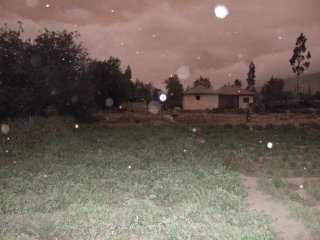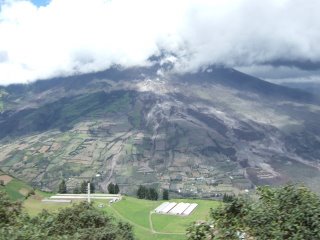August 7th, 2006 (Written by John Polga-Hecimovich, I made a few unimportant comments in brackets)
Hello all,
It has been a week since I arrived back in Quito from Tungurahua and the volcano zone, and I finally have some time to sit down and write about the experience. That pesky thesis keeps popping up to take away time.
First of all, Gabriel put up some of his stories and pictures on: http://gabrielmany.blogspot.com/, just to get an idea of how things look and what we did. Secondly, and more importantly, an enormous thank you to everyone for being so generous.
We spent the last of the donated money on Friday and Sunday, buying balanceado and afrecho and quintales of rice for the humans. Thursday, arriving in Salasaca, the sky was clear and Tungurahua was belching out ash every sixty or ninety seconds, blowing west towards Chimborazo, but nothing as bad as the inital eruptions the weeks before. In fact, only two or three times did I audibally hear the volcano erupt in my four days.
Hanging out the back end of a closed dump truck [was not a dump truck, just a delivery truck], Gabriel and I delivered 44 quintales (hundred pound sacks) of balanceado, something that looks a little bit like dog or cat food, and 26 quintales of afrecho, which are like woodchips. We had ordered more, afrecho, but the factory lied to us, and switched the order up. In the end, we delivered these to Chacauco and Bilbao, two of the communites we had visited the previous week, as well as Laurelpamba and Mucubí, two communities we had not visited. The presidents of each community signed the acknowledgement act that Gabriel had written up, and with smiles and handshakes and obvious gratutude on their part, we returned to Salasaca.
Saturday was uneventful, save a broken promise from the animal feed headquarters in Ambato; we would have to go to the Mercado Mayorista in that city the following morning to bargain for products because the company had run out of supplies and lied to us about it (I believe they are called Eco-Bal, if you are ever in Ambato and decide on a company from which NOT to purchase animal feed.) Two more friends, Berry and Kasey, from the US via Quito, arrived to help with the purchases. We rode in the back of a dump truck [really was a dump truck this time] driven by a friend of Gabriel's, and he negotiated with the venders in Ambato for prices. Fed up with the constant back and forth Ecuadorianess of it all- we didn't get a damn thing done for an hour- I took charge, and started causing a scene. The last vender finally lowered his price, and with my constant badgering, he asked, because of my bargaining, if I was from Italy. I choked up in pride. We took off with 24 sacks quintales of rice, at $18.50 [actually 18.00] a sack, and 68 or 69 of afrecho, at $9.70 a quintal.
Our negotiation strategy was-- "We don't have much money, we're spending donations, this all goes to the volcano victims" etc. Berry observed that this was almost always followed by absolutely unresponsive, unimpressed Ecuadorians. In fact, in Quito and Ambato, not one person I told about the trip asked if they could donate. That is, not one urban Ecuadorian. In Ecuador, it was, instead, the poor coastal towns whose bananas and yucca has finally arrived, or the piles of lettuce and potatoes given my the rural highland communities. It is sad to realize that all the talk about the National Soccer Team uniting the country and providing a sense of purpose was, once again, merely middle- and upper-class rhetoric. Quito seems to be worrying only about itself again.
The last part of Sunday was the deliveries, and the communities had prepared for us. San Juan and Pillate were especially profuse in theri gratitude, and arriving and leaving town was, as Gabriel put it, as close to imitating politicians as possible. Not only do I now understand how rural clientelism and vote buying works, but I think Gabriel and I could have won elections had the voters been limited to those communities. We were greeted by close to thirty people in each village, a scene of worn peasants missing teeth, wearing tattered clothing and rubber boots, and smiling in thanks, sticking out their hands to each of us and blessing us. I had learned from Gabriel, and by now I was the one talking, joking about corrupt politicians, the continued lack of government assistance, and the fact that a guinea pig will eat ANYTHING. They, in turn, laughed, listened, and were probably the best audience I have ever had. Emboldened, we posed for pictures with the town leaders and left amidst shouts of appreciation. Yet the scene was not of singing birds and sparkling meadows. Ash continues to fall on the crops, and this season's harvest is totally gone. In San Juan we all wore our surgical masks becasue ash was floating in the air, scorching throats (Respiratory ailments have filled all provincial hospitals). After our picture, one gentleman handed us rocks that had come down in one violent explosion. They were as big as my head, and a whole lot harder. I thanked him, nearly speechless, and climbed back into the bed of the dump truck.
Futures are uncertain. Bilbao, a town across the river and literally on the hillside of the volcano (and buried in ash) is being moved by the government. The citizens are worried about their fields, being relocated to a harsh and cold mountaintop, and not a low lying area, and generally changing their lifestyles. Cusúa, totally destroyed, is also being relaocated, while Chacauco, Cotaló, Laurelpamba, Mucubí, San Juan and Pillate will remain, dealing with more ash fall, possible health problems and whatever other risks go along with living next to an active volcano.
In the end, the problems that face these economically poor people are structural, not temporary. That is: these people have been farmers for generations, and volcanic minerals make that land prime peasant real estate, which means they are against moving; a lack of education and so many decades of working the land means that few people are capable of anything besides farming, and options in urban centers, namely Ambato, are limited; the government has no space to offer these people- Ecuador has the highest population density in South America and one of the top three growth rates, depending on the year (if not for up to 10% of the population emigrating since the 1999 financial crisis things would be worse). So, without economic opportunity in a capitalist society, without education in a hierarchical, clasist society, without any other available land in a pinched nation, and with a high population growth, what are the options? My personal response is much mroe extreme than anything I could fathom before seeing this area, and I can only imagine things getting worse, and not better.
I watched the movie Super Size Me on Sunday night, after having soup and some chicken and rice for dinner, my only meal since bread at breakfast. I had purchased ten pounds of quinoa in the Mayorista in Ambato, as well as fifty pounds of high quality potatoes for $1.25 (fine, they were free, but they should have been $1.25 [actually they should have been $2.50]) that day, and had been with people who never enter a supermarket their entire lives and could not fathom the idea of overeating. This mail is about Tungurahua, and not my own personal trip, but I must end this by saying that four days in the countryside was a lot more education and introspection than I ever expected.
This was not as interesting a mail as the first one, but it is an update nonetheless.
Thank you all once again. If you have any questions or concerns, please send me a mail. Looking forward to hearing from you
john












